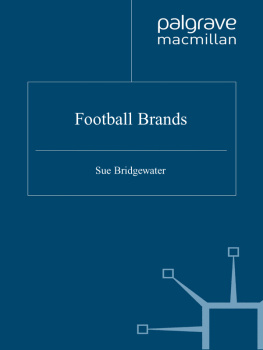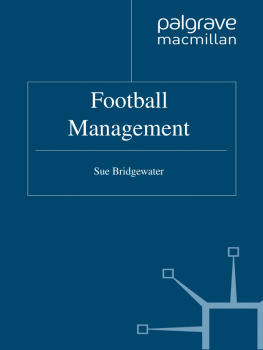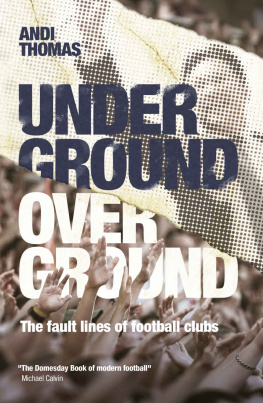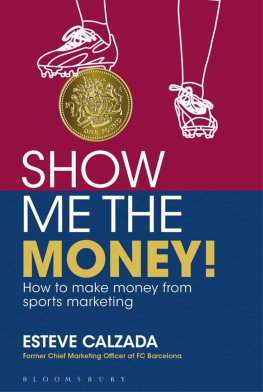Sue Bridgewater - Football Brands
Here you can read online Sue Bridgewater - Football Brands full text of the book (entire story) in english for free. Download pdf and epub, get meaning, cover and reviews about this ebook. year: 2010, publisher: Palgrave Macmillan, genre: Romance novel. Description of the work, (preface) as well as reviews are available. Best literature library LitArk.com created for fans of good reading and offers a wide selection of genres:
Romance novel
Science fiction
Adventure
Detective
Science
History
Home and family
Prose
Art
Politics
Computer
Non-fiction
Religion
Business
Children
Humor
Choose a favorite category and find really read worthwhile books. Enjoy immersion in the world of imagination, feel the emotions of the characters or learn something new for yourself, make an fascinating discovery.
- Book:Football Brands
- Author:
- Publisher:Palgrave Macmillan
- Genre:
- Year:2010
- Rating:5 / 5
- Favourites:Add to favourites
- Your mark:
- 100
- 1
- 2
- 3
- 4
- 5
Football Brands: summary, description and annotation
We offer to read an annotation, description, summary or preface (depends on what the author of the book "Football Brands" wrote himself). If you haven't found the necessary information about the book — write in the comments, we will try to find it.
Football Brands — read online for free the complete book (whole text) full work
Below is the text of the book, divided by pages. System saving the place of the last page read, allows you to conveniently read the book "Football Brands" online for free, without having to search again every time where you left off. Put a bookmark, and you can go to the page where you finished reading at any time.
Font size:
Interval:
Bookmark:
Sue Bridgewater
Warwick Business School,
University of Warwick, UK


Sue Bridgewater 2010
All rights reserved. No reproduction, copy or transmission of this publication may be made without written permission.
No portion of this publication may be reproduced, copied or transmitted save with written permission or in accordance with the provisions of the Copyright, Designs and Patents Act 1988, or under the terms of any licence permitting limited copying issued by the Copyright Licensing Agency, Saffron House, 610 Kirby Street, London EC1N 8TS.
Any person who does any unauthorized act in relation to this publication may be liable to criminal prosecution and civil claims for damages.
The author has asserted her right to be identified as the author of this work in accordance with the Copyright, Designs and Patents Act 1988.
First published 2010 by
PALGRAVE MACMILLAN
Palgrave Macmillan in the UK is an imprint of Macmillan Publishers Limited, registered in England, company number 785998, of Houndmills, Basingstoke, Hampshire RG21 6XS.
Palgrave Macmillan in the US is a division of St Martins Press LLC,
175 Fifth Avenue, New York, NY 10010.
Palgrave Macmillan is the global academic imprint of the above companies and has companies and representatives throughout the world.
Palgrave and Macmillan are registered trademarks in the United States, the United Kingdom, Europe and other countries
ISBN 978-0-230-23253-2
This book is printed on paper suitable for recycling and made from fully managed and sustained forest sources. Logging, pulping and manufacturing processes are expected to conform to the environmental regulations of the country of origin.
A catalogue record for this book is available from the British Library.
A catalog record for this book is available from the Library of Congress.
10 9 8 7 6 5 4 3 2 1
19 18 17 16 15 14 13 12 11 10
Printed and bound in Great Britain by
CPI Antony Rowe, Chippenham and Eastbourne
In memory of my parents, June and Gordon Hallard
The writing of this book on football brands would not have been possible without the kind help and access that has been provided by a number of football clubs, football bodies, and other knowledgeable individuals within the football field.
I am extremely grateful for the assistance and cooperation of Manchester United Football Club. Specifically David Gill and Philip Townsend gave generously of their time and guidance in the writing of the case study about their club and provided me with valuable insights. Without them the case study would not have been completed. At the League Managers Association, Richard Bevan, Jim Souter, and Graham Mackrell were helpful as ever, and gave insights into the brand challenges for football brands. Thanks to Verity Dodd, Pauline Healer and all involved in Sunderlands (successful!) World Cup Bid 2018 and 2022 at Sunderland AFC and Sunderland City Council for allowing me to include a case about a club and city which will always be close to my heart. Might I also thank everyone at the Football Association for involving me in research projects over the years which have helped me to explore the national and international dimension of the England football brand.
Many others helped with information, by providing useful articles and copies of their work. I am grateful to them all for their time and cooperation. Any errors or omissions are the responsibility of the author.
Sue Bridgewater
The purpose of this book is to help readers to understand why brands are important, why football clubs, football bodies, players, and tournaments are increasingly talked about in terms of brands, and the ways in which they differ and must be managed differently from other types of brands. The book combines real case histories of football brands and the challenges which they face with a reflection on what we can learn from theory in the areas of both branding and sports marketing.
The book begins with a discussion of the reasons for considering football clubs, football bodies, players, and tournaments as brands, and what insights can be gained from viewing all of these as football brands.
Marketers argue that brands are important on a number of levels. First, brands make a financial contribution to firms. Up to 70 percent of a firms earnings can be attributed to brands (Perrier 1997). Brands did not use to be mentioned in financial statements, but increasingly their value is recognized among the intangible assets of firms. Moreover, whilst the average British and American company is valued by the stock market at twice net balance sheet assets, companies with strong brands are valued at four times net assets (Financial Times 1991). Nestl paid 2.5 billion to acquire Rowntree (with its portfolio of brands such as KitKat, Smarties, and Polo mints), six times the value of the net assets of Rowntree (Doyle 2002). Second, customers build loyalty to strong brands. The decision to buy a Mercedes or a Ferrari confers much more than the ability to travel between places: the customer is buying a set of attributes, such as reliability or speed, and associations, such as prestige and status, which they and others whose opinion they value perceive in the brand.
Finally, brands now provide the guiding principles for market-oriented organizations. Over time, research attention has shifted from a focus on brand image (Boulding 1956) to the creation of brand identity (Kapferer 1997; Harris and de Chernatonay 2001). Brand image is concerned with understanding what customers value in a brand, whilst brand identity also encompasses the process of ensuring that employees values and behavior toward customers and other stakeholders are consistent with these aspects.
Given the importance of brands to marketers and in business, it is perhaps not surprising that recent decades have seen the study of brands in a broader range of organization types or sectors. Charities, the public sector, and e-marketers all seek to build brands with which customers and potential customers can identify.
The sporting world has long recognized the fervent loyalty of fans to particular sporting stars and teams. The media abounds with images of crowds turning out to greet David Beckham and his England teammates in Japan during the 2002 World Cup, the passion of Liverpool FCs Kop singing Youll never walk alone, or the amazing 40,000 fans whom, despite a difficult season for all concerned with the club, Luton Town FC recently took with them to the Johnstones Paint Trophy Final at Wembley stadium.
At the same time, the commercial significance of sport as a sector, and football in particular, has continued to grow apace in the last decade.
Sport is a significant sector in economic, social, and management terms. Globally, the market alone is estimated to be worth around $12 billion per annum (Ozanian 2005).
Within the United Kingdom, Sport England estimated the sport market at around 21.2 billion in 2008 and growing, even in a time of recession. Football (known as soccer in the United States) is one of the most globally significant sports. While many sports have appeal and commercial success within particular regions, such as baseball and ice hockey in North America, few appeal to fans in all regions of the world. Some commentators point to the different profile of football in the United States it is a participation sport and is popular with women players, while the mens game predominates in other regions. Commercially, however, Major League Soccer in the United States attracts more fans (more revenue) than does the National Hockey League (NHL), and so the sport must be viewed as globally attractive. Certainly, Manchester United, Chelsea, Real Madrid, and other big football clubs attract the loyal support of fans on a global scale.
Font size:
Interval:
Bookmark:
Similar books «Football Brands»
Look at similar books to Football Brands. We have selected literature similar in name and meaning in the hope of providing readers with more options to find new, interesting, not yet read works.
Discussion, reviews of the book Football Brands and just readers' own opinions. Leave your comments, write what you think about the work, its meaning or the main characters. Specify what exactly you liked and what you didn't like, and why you think so.










